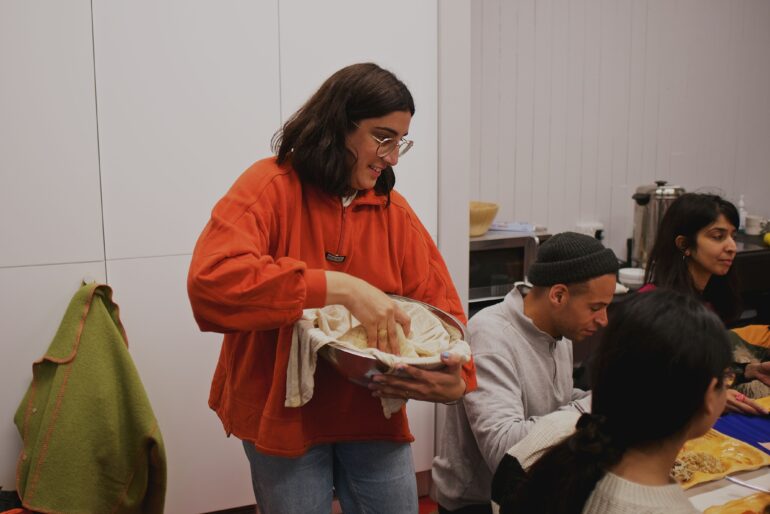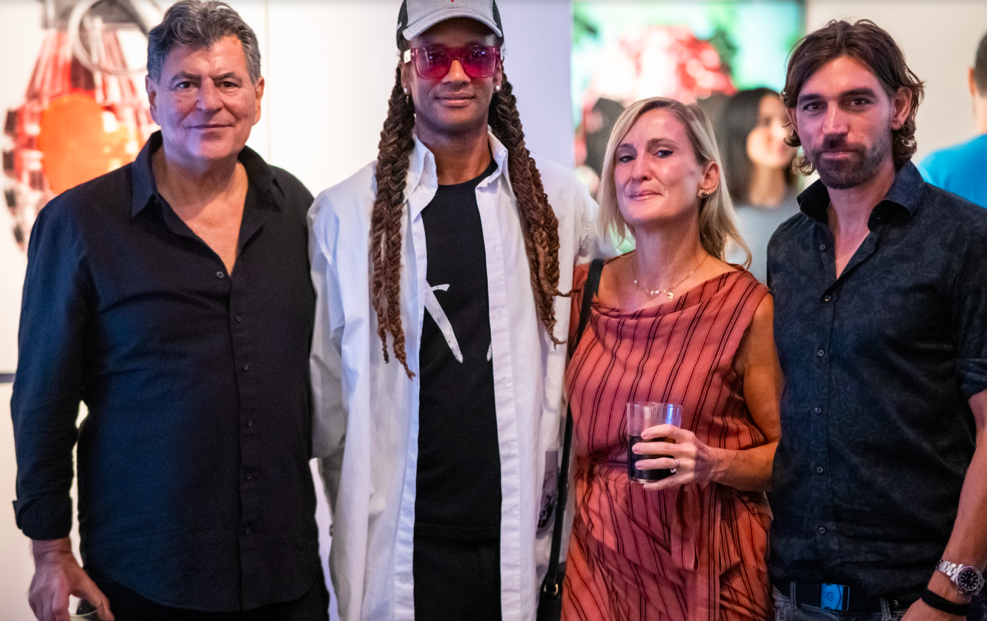As Culturalee continues to explore the intersections of identity, tradition, and contemporary expression in artistic practice, we sit down with Birmingham-based artist Roo Dhissou ahead of the upcoming exhibition Reflections – Sangat and the Self at Without Shape Without Form’s newly opened permanent gallery space in Slough.
Known for her immersive installations and deep engagement with cultural memory, Roo Dhissou invites us into a space where sound, form, and devotion intertwine.
In this conversation, Roo reflects on the significance of the manji and the practice of riyaz–daily, disciplined repetition–as frameworks that honour tradition while inviting personal transformation. She shares how the central installation functions not just as sculpture, but as a kind of “listening device,” sensitively tuned to the presence of sangat (community). And drawing on memories of the clay homes of Punjab, Roo discusses her use of earth as both material and metaphor, binding past and present through texture, resonance, and ritual.
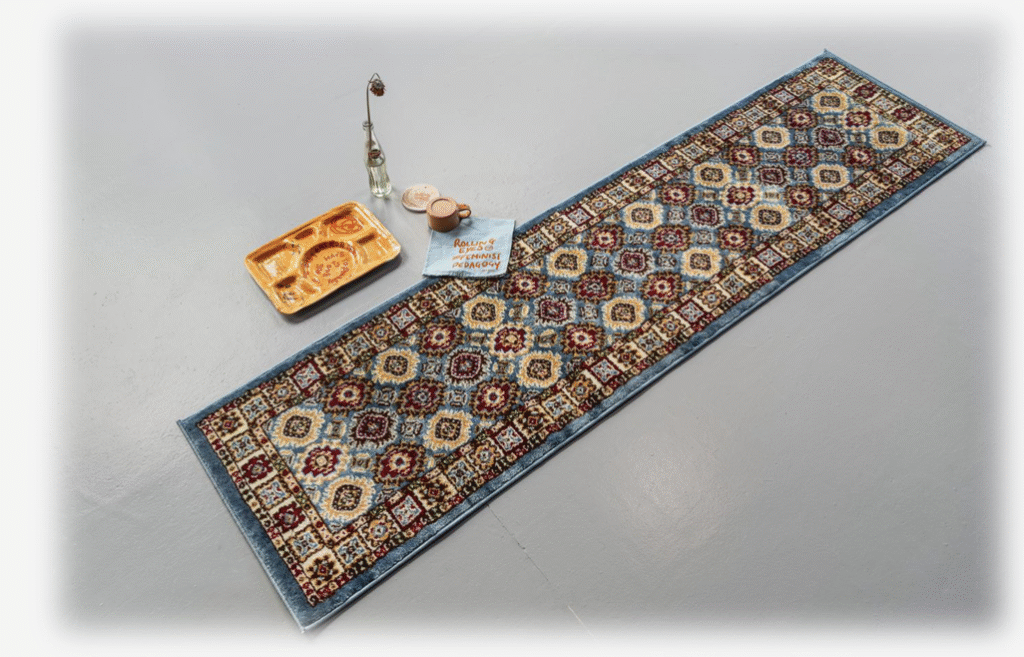
Roo Dhissou ‘But what if I gave myself an ounce of the care I show for others?’, 2023.
Your work often examines how knowledge and memory are shaped within domestic and spiritual spaces. In A String of Love, how does the manji and the concept of Riyaz speak to the role of tradition and continuous practice in shaping identity?
The manji, a hand-woven Punjabi daybed also referred to as a manja, charpai or khat, is a lived archive. Its structure holds the memory of hands, knots and tensions that pass through a community. Riyaaz, the daily and attentive practice in South Asian arts, is the rhythm that binds that archive to the present. Bringing these two forms of embodied knowledge together lets me show identity not as a fixed noun, but as something braided through repetition, care and return. Weaving is a continuous practice and Riyaaz is daily commitment to that practice. Each thread, each pattern, each day of showing up pushes the work forward while honouring what has been handed down in the past.
The manji is central to my practice. It is a piece of domestic architecture where rest, conversation, food and care all happen. It is where one sleeps under a starry night, and where we might take our first and perhaps our last breath. It is also a space, a threshold between homes, villages and publics, where many gather, wrongs can be put right, and where complexity can be held. Identity is a process that is constantly being shaped and formed. The manji threads also bend and twist; they can be restrung and re-patterned to meet the needs of its communities. In A String of Love, I pair this grounded, communal technology of care with the discipline and tenderness of riyaz. Daily practice tunes the self as much as the work. I am interested in what happens when we treat domestic gestures such as weaving and daily practice with the same seriousness that we give to classical training in the arts. How can DIY/domestic craft practices be given the same attention and rigour that the fine arts receive? The work holds those ideas and tensions.
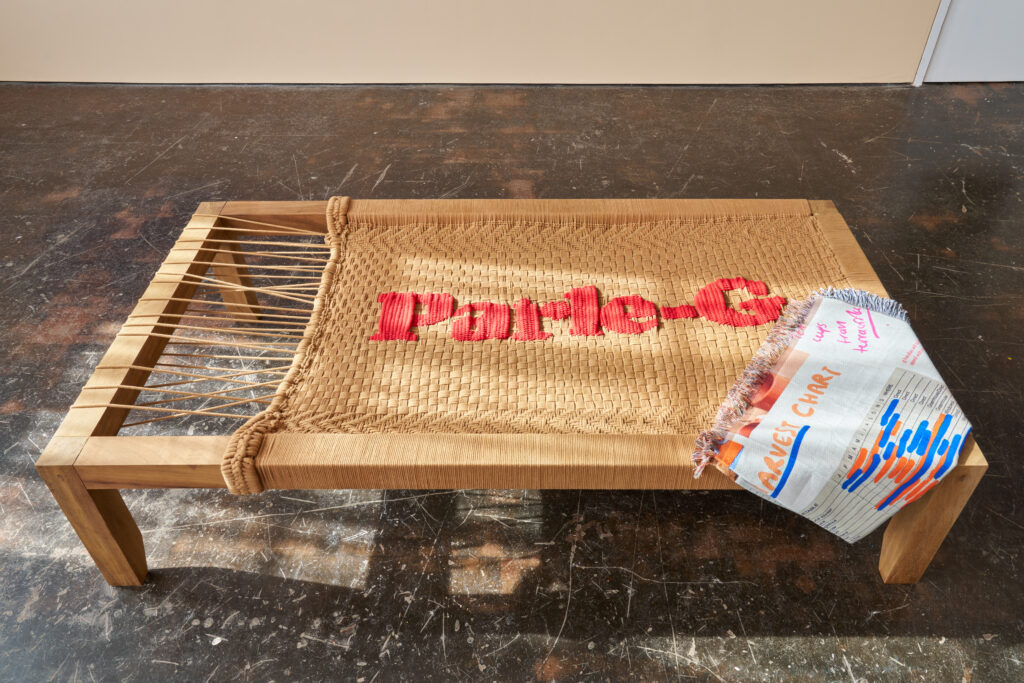
You use diverse methods, from food to publishing to installation, to challenge conventional forms of engagement. What drew you to combine handweaving with large-scale sculptural installation in this exhibition?
Much of my practice begins in the home and the kitchen, places where culture is made and remade. Cooking, hosting, publishing and circulating ideas let knowledge stay social rather than in isolation. Weaving in particular is intimate and bodily. I count with breath, I tighten and release with my hands, I listen to tension and slack. Scaling that logic into an architectural installation lets the soft knowledge of textiles become space and a fabric that people can literally inhabit. I do not see domestic practices of crafting as only women’s work. They belong to everyone across genders and generations. I have always been a space maker. I make the space for others to inhabit. Sometimes I join in. Other times, I step back and leave the space for others to make their own. The tools shift with the context: a loom, a pot of clay, a table set for a meal, a small press that carries words, a bed woven from rope, a vibration of sound. Each one opens a field of relation that help us organise and practise care together. In that sense, the work is a framework for collective authorship, and a quiet form of resistance.
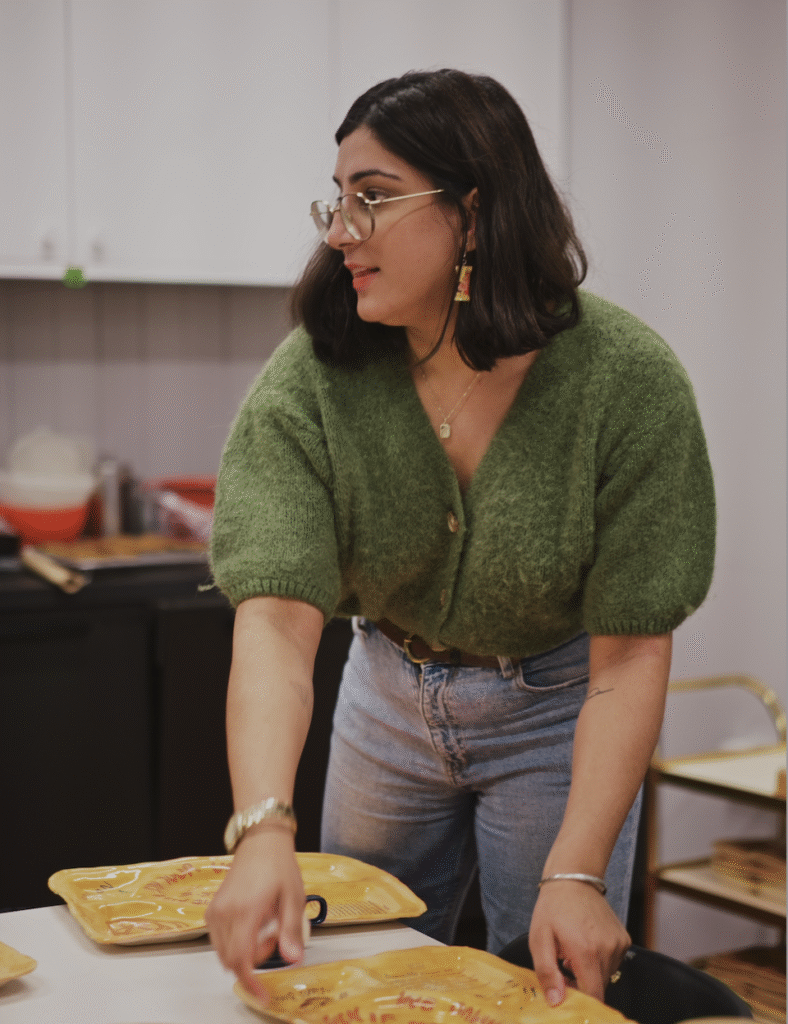
Large-scale installations feel like the most honest way to hold many parts of my practice in one body. I originally studied architecture, so I think and imagine through plans, scale, thresholds and light. Craft and cooking are in my blood and bones, generational knowledges that I carry. The thread was passed down by the women in my family, and my father, perhaps without knowing, gifted me the vision to dream up better worlds. Working at scale lets these lineages meet in one room, so domestic and diy can speak to one another and hold space for when we cannot utter in words what we want to communicate to one another. The practice becomes another language here.
As a child, I used magazines, drawings and found objects from my dad’s corner shop to imagine all the spaces I wanted to live in and be in. I cut, pasted, stacked and sketched small worlds on kitchen tables and bedroom floors. Today, I build them at a large scale, not for commercial gain, but for the communities I am part of and for the past and new versions of myself who still need them. I am interested in how slowness can be structural, and how a handmade quality can retune a public room. Translating the vernacular engineering of a manji into a spatial environment invites people to feel held rather than hurried. It resists spectacle in favour of attention, listening and rest. Softness becomes structure, and domestic labour becomes public architecture.
With Heal, Home, Hmmm, you’re working with clay excavated from HS2 sites and traditional mud building techniques. How does this choice of material reflect your ideas around access, care, and environmental responsibility in relation to both land and community?
I wanted to work with a material that many of us stand on every day, clay from the ground we share, and to use processes that are low energy, repairable and collective. Traditional mud techniques are generous and accessible. If a crack appears, you mend it with water, fibre and time. That ethic of repair models the kind of social care I am committed to, maintenance rather than disposability, and it invites participation rather than passive viewing. Last year, I took part in a materials journey with CIVIC Square and Material Cultures, the architectural collective. I have often used my practice to dream of a home I no longer have access to, my village in Punjab that I cannot return to. Many images and motifs in my work are rooted in that place and in the memories I made there as a child. This learning journey gave me practical skills in materiality and the confidence to imagine how I could rebuild that home from memory. I have been thinking about the mud huts of Punjab, and about clay ovens and fire pits, the tandoor and the chula. I also live with chronic immune and respiratory health conditions. I realised that the way I was living was contributing to those issues. Clay housing, like the one I grew up with in Punjab, is a breathable material. It releases moisture, it regulates heat, it feels alive. I began to wonder what the UK housing crisis would look like if we remembered these building techniques and lived in architecture that could be disassembled and returned to the earth rather than demolished and destroyed, which only deepens extraction and climate impact. Heal, Home, Hmmm asks that question directly and brings ideas of health, material justice and social justice together.
Contemporary life and capitalism taught me to forget the possibilities of soil and clay. Through this journey, I have begun to remember. I have rediscovered clay, straw, soil, mud, earth, cow dung, timber and the use of my own hands. I am asking how I can adapt cob building methods to create a Punjabi architectural space that also appreciates the 21st-century world we live in. My answer is not fixed, but an attempt, inspired by Birmingham brutalist architecture, and build structures that can return to the earth.
I want to build to disassemble, not demolish. I think the work itself asks its own questions, literally, as the work has a sound installation where I directly question the structure through sound and my voice, made in collaboration with friend and frequent co-worker Oliver Romoff.
How can we make artworks that are disassembled or returned to the soil after our lifetime? How can we challenge contemporary art collections and conservation so that some works can be composted, temporary, returned, or disassembled? How can we retrofit existing structures? Everything is entangled. Material justice is not a single issue, so it cannot have a single issue solution. How do we host artists with access needs, disabilities and chronic illness while also creating space for material and environmental justice?
Using clay connected to a major infrastructure project is also an act of acknowledgement. Such projects disturb land and communities. Transforming spoil into shelter is a way to meet that disturbance with responsibility rather than denial. The making of this pavilion is collaborative, from sourcing to building to sound, because access is not only about ramps and labels, although those matter. It is also about who gets to design, build and voice a space. I worked with Rescued Clay and have found so much community in my time working with them, I have reconnected with peers in the material world and formed life-long family here too. Ultimately, the work argues for an ecology of care and demanding collective work. This work is a literal testament to all those who were involved. From the architects, to the plasterers. I would like to thank Intervention Architecture for believing in my vision and bringing it to life through their industry knowledge, without them and Rescued Clay, I’d have nothing but an idea.
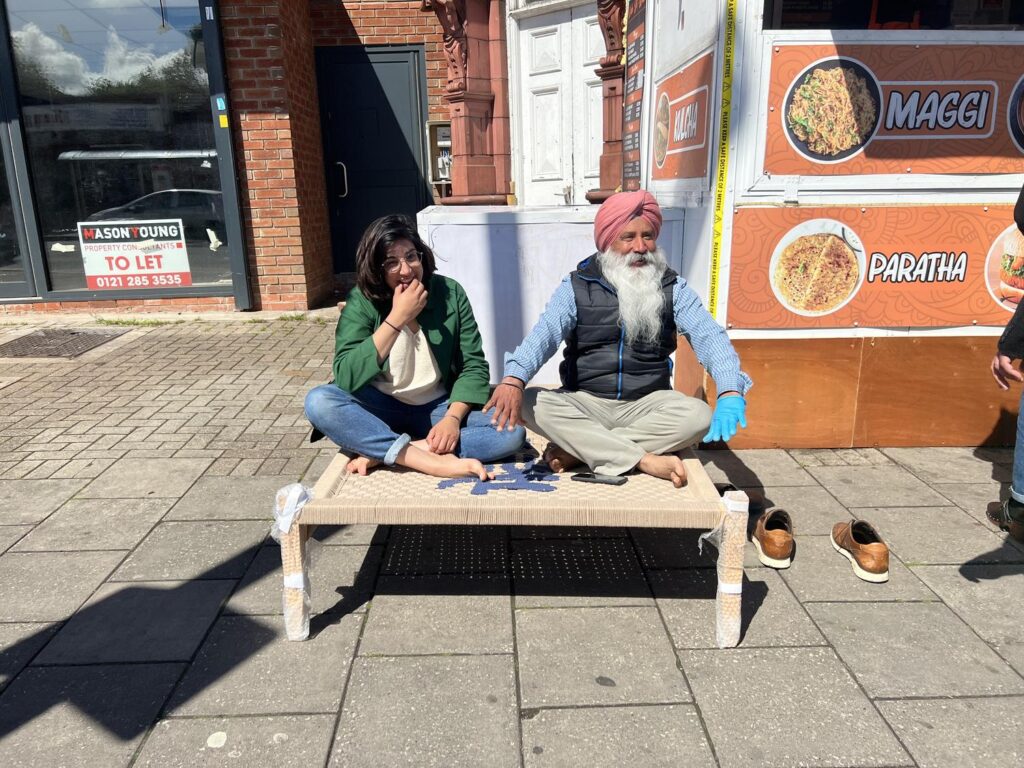
Your installations invite viewers to reconsider how we relate to one another and the spaces we inhabit. What kinds of conversations or emotional responses do you hope Reflections sparks in audiences engaging with your work?
I hope people feel permission to slow down, to rest, and to notice who and what quietly supports them. If it works, the installation acts like a listening device. It softens the voice, steadies the breath, and opens room for stories of inheritance, repair, grief and joy to sit side by side. I am especially keen for the show to kindle conversations about daily practice, how riyaz or routine acts of care can stabilise a life, and about sangat, the power of gathering with intention.
If visitors leave with even one concrete idea for how to make their own spaces more tender and more resilient, whether that is a revised routine at home, a renewed relation to neighbours, or a different pace of attention in public, then the work has done its job. Otherwise, I am very content with visitors simply sitting or lying down in the spaces I have created and just marking a moment of rest for themselves.
Reflections – Sangat and the Self featuring Jasmir Creed & Roo Dhissou runs from 19th September 2025 until 2nd May, 2026 at Without Shape Without Form HQ in Slough.


